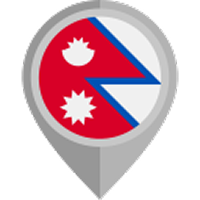Nepal vision | 06/03/2025
The Everest Three Pass Trek is one of the most astounding trekking experiences in the lap of the world’s highest peak, Everest. Many adventurers take up the challenge to explore the natural and cultural gems of the remote Everest region.
Passing through the well-marked trail, spinning the prayer wheel, having a quick chat with friendly Sherpa people, and visiting various small and large monasteries, the Everest Three Pass Trek unveils the hidden treasures of Khumbu, offering an immersive experience of Sherpa culture. Crossing the wooden bridges, the mani walls, and the lush rhododendron forests, we encounter the endangered species of Sagarmatha National Park, with the charming smiles of Mount Everest, Lhotse, Nuptse, Makalu, and Ama Dablam. These are among the unforgettable experiences the trek provides.
Now comes the part every adventurer is curious about: the details of the adventure. We’ve gathered all the information about the Everest Three Pass Trek to help make your next adventure genuinely memorable.
Everest Three Pass Trek Overview
Unlike the classic Everest Base Camp Trek, the Everest Three Pass Trek is the ultimate adventure of the Everest region. The natural aura of the remote area of Everest alongside the unique and appealing cultural gem of local Sherpa people with the mix of the physical challenge of crossing three high passes is what the Everest Three Pass Trek rewards trekkers with.
Start with the scenic flight from Kathmandu to Lukla, exploring the 360-degree views of the Kathmandu and soaring down in the gateway of Everest. From Lukla, you start your official walk towards Namche on the well-marked trail. Further, staying a night in Namche and exploring the beautiful town in the lap of the Himlayas, you start your journey to an even more rugged and remote region, as now you will walk through the muddy trail crossing the diverse flora and fauna of Sgaramatha National Park and different cultural artefacts of the area.
You’ll follow in the footsteps of famous explorers, crossing Kongma La, and then head to Everest Base Camp (5,364 meters). From there, you’ll visit Kala Patthar (5,550 meters), the place where golden rays of sunrise strike the majestic peak. This place shows off its charm with fantastic sunrise views and panoramic vistas of the surrounding mountains.
The finale of the adventure comes when you cross Cho La, which leads you to Gokyo (4790 m), a high-altitude village known for its beautiful turquoise lakes. You’ll have a rest day there and can hike up to Gokyo Ri (5360 m) for incredible views of Everest, Makalu, and Cho Oyu. After crossing Renjo La, the trail descends through Thame Valley, and the trek ends at Namche Bazaar before returning to Lukla.
Throughout this fantastic trekking journey, there are plenty of things to explore and highlights not to miss.
Highlights of the Everest Three High Passes Trek
- Crossing the Tumbling Dudh Koshi River: Enjoying the natural beauty of the Everest region as you cross the rushing river and marvel at the landscape around you.
- Visiting Monasteries and Immersing in Sherpa Culture: Spin prayer wheels, read the ancient inscriptions on mani walls, and pay visits to various monasteries, all while soaking in the captivating Sherpa culture.
- Encountering Endangered Species in Sagarmatha National Park: Along the trek, you'll pass through Sagarmatha National Park, home to endangered species such as the snow leopard, red panda, and Himalayan tahr.
- Taking on the Challenge of Three High Passes: The trek’s most daring feature is crossing three of the highest mountain passes in the Himalayas: Kongma La, Cho La, and Renjo La.
- Witnessing Iconic Sunrises and Sunsets: Experience unforgettable sunrises and sunsets against the backdrop of the world's highest peaks, including Everest, Lhotse, Makalu, and Cho Oyu, all from stunning viewpoints like Kala Patthar and Gokyo Ri.
Everest High Passes Circuit Route Difficulty
The Everest Three Pass Trek is challenging in the Everest region due to different factors, including its difficulty. Let us take a brief look at them:
Physical Demands
The diverse landscape of the trail taking to the Everest High Pass Trek involves hiking hours, steep ascents, and descents, causing an extreme physical demand. The steep uphill, the rocky surface, and the uneven land are enough to challenge your body physically. Similarly, the speed asent and desent are enough to put your knees and joints.
Further, the remote region of Everest makes the trails a bit tricky, so trekkers need to be in good physical condition and have good navigation skills.
Altitude Sickness
Aside from the physical demands, the trek you will take you over the altitude of 5000m where the air is thin and oxygen levels are lower. In such a situation, it is obvious your body will suffer from altitude sickness. In the initial days, you will experience symptoms like headache, vomiting, nausea, fatigue, and shortness of breath. Diamox can be the best way to relieve the initial symptoms. Still, if the situation becomes severe, it will cause life-threatening conditions like high-altitude cerebral edema (HACE) and high-altitude pulmonary edema (HAPE) that require medical help.
To prevent this, you must perform proper acclimatization, stay hydrated, and slow your pace by listening to your body.
Technical Difficulty
Some sections of the Everest Three Pass Trek are technically challenging. Kongma La and Cho La may require more than just regular hiking. These high mountain passes involve scrambling, where trekkers need to climb over rocks or navigate through steep, uneven terrain.
In the winter or early spring, the trails can become even more complicated, with ice and snow making the paths slippery. During these times, trekkers may need to use specialized equipment, such as ice axes or crampons, to ensure safe passage across glaciers and ice-covered sections. These technical challenges require physical endurance and the ability to handle more demanding and precarious sections of the trail.

How to Prepare for the Everest Three Pass Trek
Despite being one of the most challenging treks, many trekkers from all around the world are up for the Everest Three Pass Trek for an unforgettable moment in the lap of Everest. Thus, preparing for the trek will help them start their trip in the Himalayas.
Physical Preparation
Good physical preparation is essential since the Everest Three Pass Trek involves physical demands, including long hours of hiking with steep ascents, descents, and high-altitude crossings.
- Initial days: Start by walking more often and taking the staircase to get your body started.
- Cardio and Endurance: To start the training regime, include cardio endurance and strength training in your workout.
- Backpack Practice: Practice hiking with a loaded backpack, gradually increasing the weight and distance to simulate the conditions of the trek.
Mental Preparation
Mental toughness is a non-negotiable aspect of the Everest Three Pass Trek. Long walking days in a remote place can take a toll on your mindset. To prepare mentally, you should engage in activities that challenge your patience and focus to build resilience. Furthermore, visualizing the rewards of the trek and the sense of achievement will help you stay motivated throughout the journey.
Choosing the Right Time
Choosing the best time for the Everest Three Pass Trek is a must for a safe and enjoyable experience. Long walking days, cultural festivities, a vibrant atmosphere, nature regaining its beauty, and good trail conditions make spring and autumn the ideal seasons for trekking in this region.
These are the peak seasons, so one should book in advance to avoid the crowds. In summer, the monsoon season arrives, making the trail slippery and posing a high risk of landslides. At the same time, winter trekking is possible, but in mid-winter, the harsh weather makes crossing the high passes much more difficult.
Travel Insurance
Travel insurance is highly recommended for any trek, especially one as demanding as the Everest Three Pass Trek. The unpredictable nature of high-altitude trekking makes it essential to have coverage for emergencies and unexpected situations. A good travel insurance policy should include:
- Medical Expenses
- Emergency Evacuation & Rescue
- Trip Cancellations & Delays
- Lost or Delayed Baggage
- High-Altitude Trekking Coverage
- Personal Liability
- Flight Issues
Packing
- Clothing: Base layers (moisture-wicking), Insulating layers (fleece/down jacket), Waterproof jacket & pants, Trekking pants & shirts, Warm gloves & hat, Buff or neck gaiter
- Footwear: Sturdy trekking boots (waterproof), Comfortable trekking socks (wool/synthetic), Camp shoes/sandals
- Backpack & Storage: Trekking backpack (40-50L), Daypack (for short hikes), Dry bags & waterproof covers
- Sleeping Gear: Sleeping bag (-10°C to -20°C rating), Sleeping pad (optional)
- Trekking Equipment: Trekking poles, Headlamp & extra batteries, Sunglasses (UV protection), Water bottles & hydration system
- Personal Items: First aid kit & medications, Sunscreen & lip balm, Toiletries & wet wipes, Quick-dry towel
- Navigation & Electronics: Map & compass (or GPS device), Power bank & charging cables, Camera & extra batteries
- Technical Gear (if needed): Microspikes/crampons, Ice axe, Gaiters
Permit Required
When trekking in the Everest region, you’ll need two essential permits for the Nepal Vision Trek. These permits allow access to the Khumbu region and Sagarmatha National Park, both of which are required for trekking in this area. Your guide will assist you in obtaining these permits using your passport.
Khumbu Pasang Lhamu Rural Municipality Entrance Permit:
- Cost: NPR 3000 per person
- Available: Paid in person in Lukla (not available in Kathmandu)
Sagarmatha National Park Entry Permit:
- Cost: NPR 3000 per person
- Available: Can be obtained in Kathmandu at the Nepal Tourism Board Office or in Monjo at the Park Entrance Gate
To wrap up, The Everest Three Pass Trek is a challenging but rewarding adventure, taking you through high-altitude passes, stunning mountain views, and the Sherpa culture. With proper preparation, the trek offers a memorable experience. Ensure you have the right gear, permits, and mental readiness to make the most of this journey.
For a smooth and memorable trek, contact Nepal Vision Trek for expert support and guidance.
FAQS









